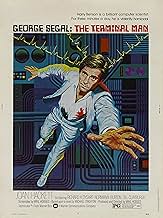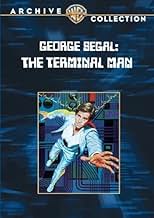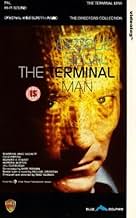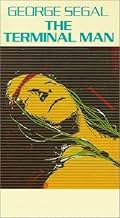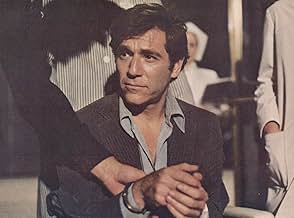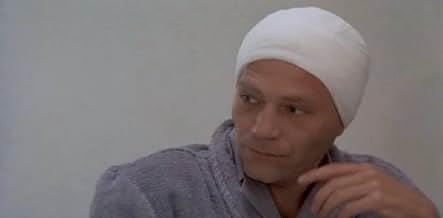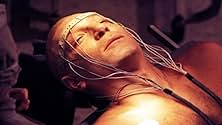Hoping to cure his blackout seizures which turn him temporarily extremely violent, a computer scientist agrees to an experimental brain computer chip implant surgery.Hoping to cure his blackout seizures which turn him temporarily extremely violent, a computer scientist agrees to an experimental brain computer chip implant surgery.Hoping to cure his blackout seizures which turn him temporarily extremely violent, a computer scientist agrees to an experimental brain computer chip implant surgery.
- Dr. John Ellis
- (as Richard A. Dysart)
- Det. Capt. Anders
- (as Normann Burton)
- Director
- Writers
- All cast & crew
- Production, box office & more at IMDbPro
Featured reviews
This is a Michael Crichton book. The prolific writer has some big ideas but it often takes a good adaptation to inject a compelling narrative. This movie doesn't have it. The story is drawn-out and slow-moving. The surgery takes forever and generates little tension. The second half tries to turn into something else. By then, most people would have already lost interest. This movie may work better if it skips a lot of the surgery minutia. The story may have some social commentary to make but it's just too darn slow.
George Segal is believable as Harry, and the rest of the cast is fine, and though Mike Hodges tries, this film is simply too dreary and downbeat to succeed, and by the end, there doesn't seem to have been any discernible point to it all.
That's one thing you need to know going in. The other is not that it's slow, but that it spends a ridiculous amount of time on the fictitious surgery. For example, the doctor almost hits a vein in the patient's brain which would have killed him. However, a surgical mistake can happen in any sort of surgery and this lengthy bit doesn't address the far more interesting ethical issues.
This is in contrast to The Andromeda Strain. In that film, there are enormously detailed and lengthy scenes of the Wildfire lab. But the difference is that movie was more about the scientists and the lab than the germ itself. Here, that's just not the case.
There's other parts of the film that provide a weird atmosphere yet seem entirely irrelevant. The doctor goes to a strip club to find Segal and while I like the music played, it's hard to see why this is here considering it's mostly focused on the stripper stage.
The far more interesting issues are of course the ethical ones.
The treatment they give this man is directly compared to lobotomies, a very dark page of medical history. After they install the device, they start activating different electrodes to see what happens... this isn't that much different than the lobotomy performed on Rosemary Kennedy where they kept cutting while talking to her to see the effects. It's incredibly chilling and plausible.
A curiosity here is that there is essentially an ad for Scientology on the radio in the background in one scene. This makes sense considering their disdain for psychiatry which was rather well founded at least at the time.
There's frustration here in that one huge theme seems to have been all but ignored-- that the patient was convinced computers would take over. I suppose the idea might have been that Segal was increasingly acting robotic... in several scenes when he's walking he does seem like a mindless drone. But I just saw him as a zonked out zombie and zombies are standard horror fare. It didn't occur to me that that might have been the idea until I was writing this review.
Anyway, it's a fascinating watch as long as you know what you're getting into. It's definitely NOT a thriller. There are many striking visuals, like a long curious zoom on a parrot.
Today's audiences however, with their short attention spans, will likely be permanently disappointed. To those who complain that this film is "slow" (and they are legion); I would say to either learn some patience, or simply avoid the film and go back to watching action/adventure.
While made in the early 1970's, it is highly relevant to today's world as well. Replace the "wires in the brain" with today's over-prescribed Ritalin, SSRI's, and other similar drugs, and you will see the point.
This is an excellent movie which deserves to be on DVD, with commentary by Crichton, Hodges and/or Segal. They are all still with us as of 4/2008 (Sadly Ms. Hackett is not). The sooner the better.
Did you know
- TriviaCrichton was fired from writing the screenplay due to the fact that his script did not follow the novel (which he had written) closely enough.
- GoofsAt the cemetery, the usual mechanism for lowering the coffin into the grave is missing. There aren't even any straps in place to lower it manually.
- Quotes
Benson: [mumbles]
Dr. John Ellis: [operating on Benson] What was that?
Dr. Robert Morris: Patient.
Dr. John Ellis: You all right, Mr. Benson?
Benson: [groggily] Fine... fine...
Dr. John Ellis: Any pain?
Benson: No...
Dr. John Ellis: Good. Just relax now.
Benson: You too doctor...
- Alternate versionsOn its release at 2003 Edinburgh Film Festival, there was a director's cut which Hodges had cut out the beginning with the doctor looking at photographs of Harry Benson.
- ConnectionsFeatured in Cinemacabre TV Trailers (1993)
- SoundtracksGoldberg Variation No. 25
by Johann Sebastian Bach (as J.S. Bach)
Played by Glenn Gould
Courtesy Columbia Records
- How long is The Terminal Man?Powered by Alexa
Details
Box office
- Gross US & Canada
- $224,542
- Runtime
- 1h 44m(104 min)
- Sound mix
- Aspect ratio
- 1.85 : 1


